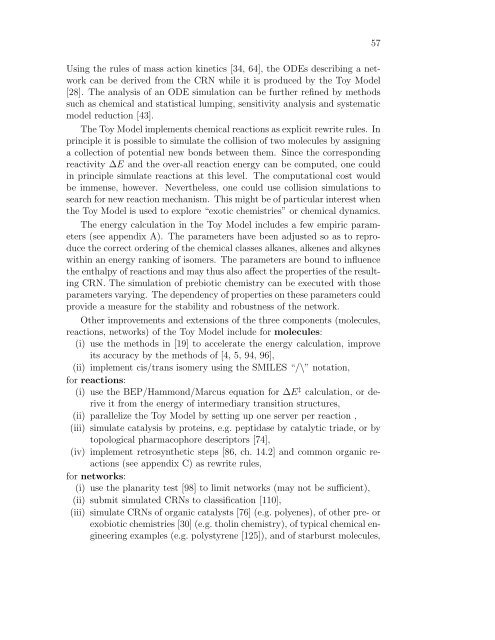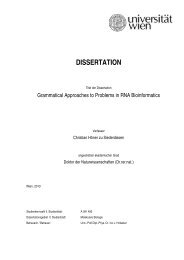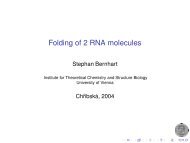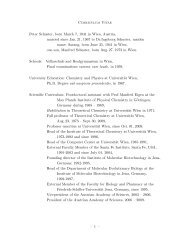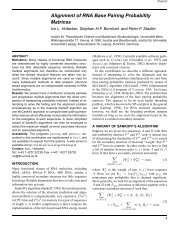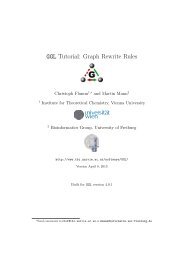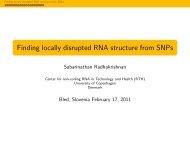A Toy Model of Chemical Reaction Networks - TBI - Universität Wien
A Toy Model of Chemical Reaction Networks - TBI - Universität Wien
A Toy Model of Chemical Reaction Networks - TBI - Universität Wien
You also want an ePaper? Increase the reach of your titles
YUMPU automatically turns print PDFs into web optimized ePapers that Google loves.
Using the rules <strong>of</strong> mass action kinetics [34, 64], the ODEs describing a network<br />
can be derived from the CRN while it is produced by the <strong>Toy</strong> <strong>Model</strong><br />
[28]. The analysis <strong>of</strong> an ODE simulation can be further refined by methods<br />
such as chemical and statistical lumping, sensitivity analysis and systematic<br />
model reduction [43].<br />
The <strong>Toy</strong> <strong>Model</strong> implements chemical reactions as explicit rewrite rules. In<br />
principle it is possible to simulate the collision <strong>of</strong> two molecules by assigning<br />
a collection <strong>of</strong> potential new bonds between them. Since the corresponding<br />
reactivity ∆E and the over-all reaction energy can be computed, one could<br />
in principle simulate reactions at this level. The computational cost would<br />
be immense, however. Nevertheless, one could use collision simulations to<br />
search for new reaction mechanism. This might be <strong>of</strong> particular interest when<br />
the <strong>Toy</strong> <strong>Model</strong> is used to explore “exotic chemistries” or chemical dynamics.<br />
The energy calculation in the <strong>Toy</strong> <strong>Model</strong> includes a few empiric parameters<br />
(see appendix A). The parameters have been adjusted so as to reproduce<br />
the correct ordering <strong>of</strong> the chemical classes alkanes, alkenes and alkynes<br />
within an energy ranking <strong>of</strong> isomers. The parameters are bound to influence<br />
the enthalpy <strong>of</strong> reactions and may thus also affect the properties <strong>of</strong> the resulting<br />
CRN. The simulation <strong>of</strong> prebiotic chemistry can be executed with those<br />
parameters varying. The dependency <strong>of</strong> properties on these parameters could<br />
provide a measure for the stability and robustness <strong>of</strong> the network.<br />
Other improvements and extensions <strong>of</strong> the three components (molecules,<br />
reactions, networks) <strong>of</strong> the <strong>Toy</strong> <strong>Model</strong> include for molecules:<br />
(i) use the methods in [19] to accelerate the energy calculation, improve<br />
its accuracy by the methods <strong>of</strong> [4, 5, 94, 96],<br />
(ii) implement cis/trans isomery using the SMILES “/\” notation,<br />
for reactions:<br />
(i) use the BEP/Hammond/Marcus equation for ∆E ‡ calculation, or derive<br />
it from the energy <strong>of</strong> intermediary transition structures,<br />
(ii) parallelize the <strong>Toy</strong> <strong>Model</strong> by setting up one server per reaction ,<br />
(iii) simulate catalysis by proteins, e.g. peptidase by catalytic triade, or by<br />
topological pharmacophore descriptors [74],<br />
(iv) implement retrosynthetic steps [86, ch. 14.2] and common organic reactions<br />
(see appendix C) as rewrite rules,<br />
for networks:<br />
(i) use the planarity test [98] to limit networks (may not be sufficient),<br />
(ii) submit simulated CRNs to classification [110],<br />
(iii) simulate CRNs <strong>of</strong> organic catalysts [76] (e.g. polyenes), <strong>of</strong> other pre- or<br />
exobiotic chemistries [30] (e.g. tholin chemistry), <strong>of</strong> typical chemical engineering<br />
examples (e.g. polystyrene [125]), and <strong>of</strong> starburst molecules,<br />
57


